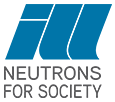From newcomers to neutron explorers - Portraits from the NEPHEWS Twinning Programme
Portraits from the NEPHEWS Twinning Programme
The ILL recently welcomed the first 'novice users' as part of the exchange programme. Below are the portraits of three scientists, in various stage of their careers, discovering the ILL for the first time.
The NEPHEWS Twinning Programmeis an innovative exchange initiative designed to pair “novice users” - researchers unfamiliar with large-scale facilities - with experienced research groups (“twins”) at European neutron, synchrotron, and free-electron laser infrastructures. Over the course of one period of beamtime, these participants join hands-on experiments, learning organizational and technical skills directly from both experienced users and instrument scientists.
NEPHEWS supports this immersive learning by covering travel and accommodation expenses, inviting researchers at all career stages - especially those from widening countries and Ukraine - to gain practical expertise, foster long-term collaborations, and build confidence in designing their own future experiments.
The NEPHEWS project is scheduled to run until December 2026, so there is still a possibility to apply to the NEPHEWS programme by filling out the short registration form online.
Nicolas Schaeffer : advancing sustainability-focused research
Nicolas Schaeffer is an Assistant Researcher at CICECO – Aveiro Institute of Materials in Portugal, with a background in chemical engineering and physical chemistry. His research focuses on developing innovative solvents for hydrometallurgy, particularly liquid–liquid separation of metal ions, with applications in resource recovery and sustainability.
In 2023, he was awarded a prestigious ERC Starting Grant to advance his work on hydrophobic eutectic solvents for green recycling technologies.
Through the NEPHEWS Twinning Programme, Nicolas had the opportunity to explore the capabilities of ILL’s small-angle diffractometer D22. He admitted that these “big instruments” once felt intimidating from the outside, but the twinning experience gave him the chance to demystify the processes and gave him the tools to start designing neutron experiments himself and, with guidance, to apply for beamtime — a key step towards integrating neutrons into his research.
Vlada Pashynska : pushing the frontiers of biophysics
Dr. Vlada Pashynska is a senior researcher at the B. Verkin Institute for Low Temperature Physics and Engineering in Kharkiv, Ukraine, where she specializes in molecular biophysics. With the war in Ukraine making it increasingly difficult to carry out experiments at home, Vlada applied to the NEPHEWS Twinning Programme to continue pursuing her scientific aims.
As a result, Vlada joined users from Sweden for an experiment using a size exclusion chromatography (SEC) system on the ILL’s D22 small-angle neutron scattering instrument (SANS). For her, the experience was remarkable - not only for the scale of the setup, which she described as “so big, so impressive,” but also because it brought her closer to techniques that complement her own field.
Moreover, Vlada was also introduced to local scientists from the nearby IBS institute working in mass spectrometry - opening new perspectives for future collaborations also with her main investigation technique. Altogether, the Twinning Programme gave her a chance to see firsthand how neutron methods can support molecular biophysics and to consider how she might design experiments serving her scientific goals in the future.
Kinga Szarkowska : completing a Master's with experience at a Large-Scale Facility
Kinga Szarkowska is a Master’s student at the University of Białystok, Poland, who joined the NEPHEWS Twinning Programme on the recommendation of her mentor, Katarzyna M. Recko.
Until then, her research on magnetite nanoparticles doped with lanthanides had relied mainly on X-ray techniques. The twinning stay at the ILL opened up a completely new perspective: she could work directly with neutron scattering experts and discover how these methods could complement her own studies. For Kinga, the experience was not only about learning new techniques, but also about building confidence as a young researcher - discussing her many questions with the D20 instrument scientist and even reworking a previously rejected beamtime proposal with expert guidance.
The portraits below show how connecting scientists with complementary expertise not only transfers technical know-how but also equips participants to take their next steps with large-scale facilities.

